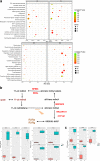Transcriptomic profiling reveals molecular regulation of seasonal reproduction in Tibetan highland fish, Gymnocypris przewalskii
- PMID: 30606119
- PMCID: PMC6318897
- DOI: 10.1186/s12864-018-5358-6
Transcriptomic profiling reveals molecular regulation of seasonal reproduction in Tibetan highland fish, Gymnocypris przewalskii
Abstract
Background: The Tibetan highland fish, Gymnocypris przewalskii, migrates from Lake Qinghai to its spawning grounds every summer. This seasonal reproduction is critically regulated by intrinsic and extrinsic signals. However, the molecular mechanisms that process environmental oscillations to initiate the seasonal mating are largely unknown.
Results: A transcriptomic analysis was conducted on the brain and gonad of male and female G. przewalskii in reproductive and nonreproductive seasons. We obtained 2034, 760, 1158 and 17,856 differentially expressed genes between the reproductively active and dormant female brain, male brain, ovary and testis. Among these genes, DIO2 was upregulated in the reproductively active brain and gonad of both males and females. Neuroactive ligand-receptor genes were activated in male and female brain. Functional enrichment analysis suggested that retinol metabolism was uniquely stimulated in reproductively active males. Genes involved in GnRH signaling and sex hormone synthesis exhibited higher expression levels in brain and gonad during the reproductive season. A co-expression network classified all the genes into 9 modules. The network pinpointed CDC42 as the hub gene that connected the pathways in responsible for modulating reproduction in G. przewalskii. Meanwhile, the sex pheromone receptor gene prostaglandin receptor was identified to link to multiple endocrine receptors, such as GnRHR2 in the network.
Conclusions: The current study profiled transcriptomic variations between reproductively active and dormant fish, highlighting the potential regulatory mechanisms of seasonal reproduction in G. przewalskii. Our data suggested that the seasonal regulation of reproduction in G. przewalskii was controlled by the external stimulation of photoperiodic variations. The activated transcription of neuroendocrine and sex hormone synthesis genes contributed to seasonal reproduction regulation in G. przewalskii, which was presumably influenced by the increased day-length during the breeding season.
Keywords: Day-length; Neuroendocrine; RNA-seq; Reproductive migration; Seasonality; Tibetan highland fish; WGCNA.
Conflict of interest statement
Ethics approval and consent to participate
The field study was authorized and supervised by Qinghai Provincial Bureau of Fishery. All animal experiments were approved by the Animal Care and Use Committees of the Northwest Institute of Plateau Biology, Chinese Academy of Sciences.
Consent for publication
Not Applicable.
Competing interests
The authors declare that they have no competing interest.
Publisher’s Note
Springer Nature remains neutral with regard to jurisdictional claims in published maps and institutional affiliations.
Figures





References
-
- Kennaway DJ , Rowe SA. Melatonin binding-sites and their role in seasonal reproduction. J Reprod Fertil. 1995;49(1):423–35. - PubMed
MeSH terms
Grants and funding
LinkOut - more resources
Full Text Sources
Miscellaneous

